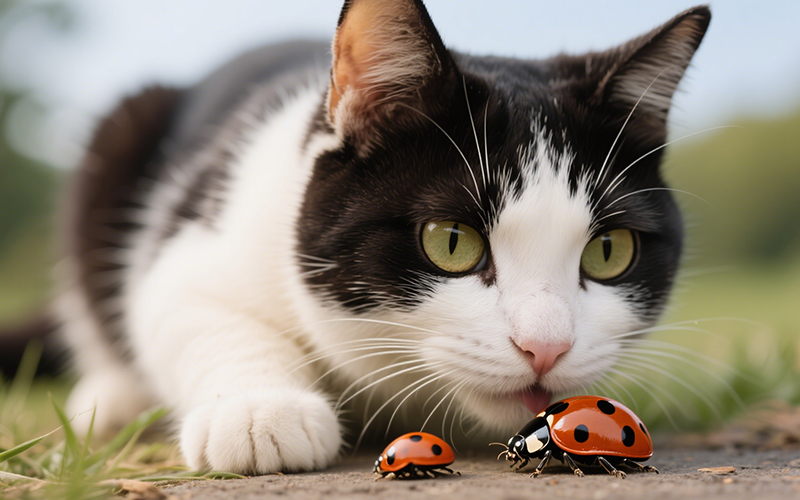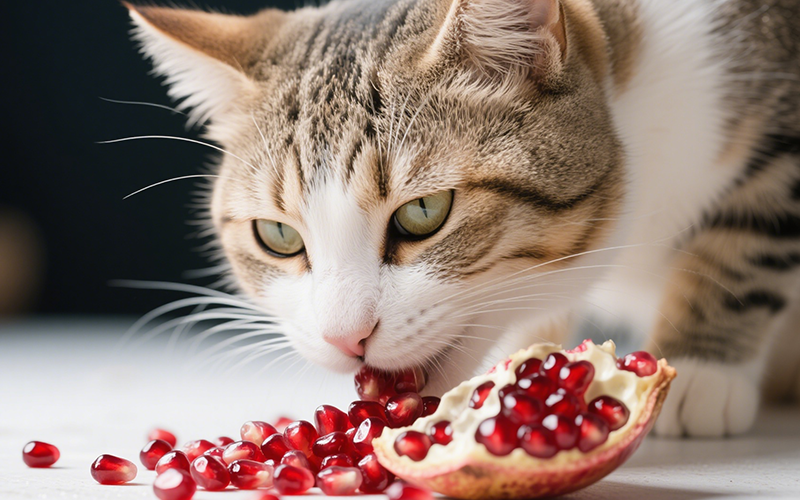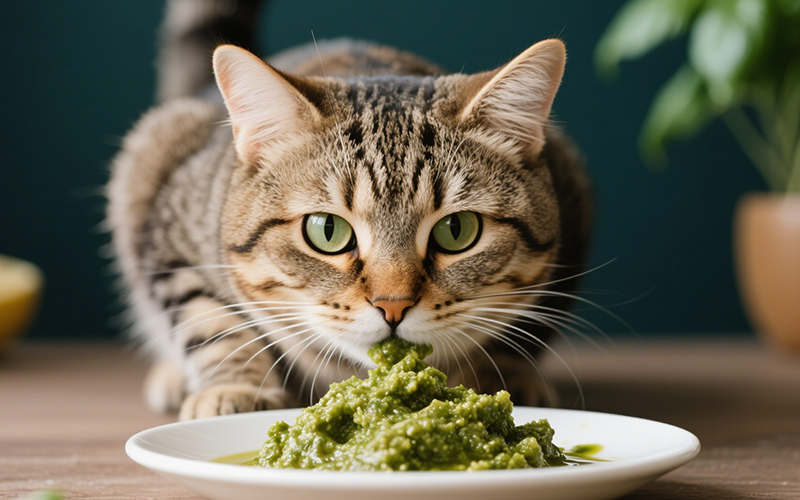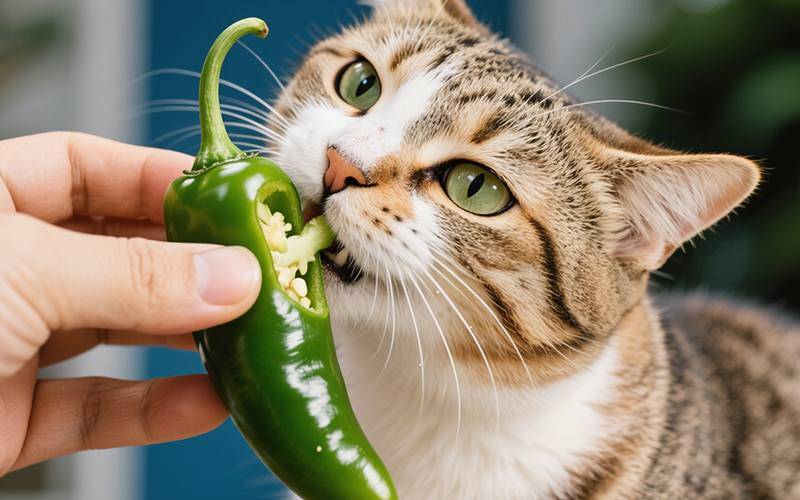Curious Paws & Colorful Bugs: Can Cats Eat Ladybugs Safely? (Vet Insights)
- 11 Apr 2025 15:54
Cats, with their innate curiosity and finely tuned hunting instincts, often find small, moving creatures irresistible. From dust bunnies skittering across the floor to flies buzzing near a window, their attention is easily captured. Among these potential tiny "toys" are ladybugs, whose bright colors and slow movements can make them particularly intriguing targets for our feline friends. This naturally leads concerned pet parents to ask: can cats eat ladybugs? Is this seemingly innocent interaction harmless, or does munching on these spotted beetles pose a risk?
While the image of a cat batting at a ladybug might seem cute, understanding the potential consequences of ingestion is crucial for responsible pet ownership. Unlike some human foods occasionally shared with pets, insects introduce a different set of variables, including natural defense mechanisms. This article delves into the specifics of cats eating ladybugs, drawing on veterinary knowledge and entomological facts to provide a clear, authoritative answer grounded in the principles of E-E-A-T (Experience, Expertise, Authoritativeness, Trustworthiness).

Understanding Ladybugs: More Than Just Cute Beetles
Ladybugs, also known as lady beetles or ladybird beetles (family Coccinellidae), are generally perceived positively by humans as beneficial insects that prey on garden pests like aphids. Their characteristic bright red or orange shells with black spots serve a purpose beyond aesthetics – it's a form of aposematism, a warning signal to potential predators that they might be unpalatable or even toxic.
A key defense mechanism ladybugs employ is "reflex bleeding." When threatened, they can secrete droplets of hemolymph (insect blood) from their leg joints. This fluid contains noxious, foul-smelling, and bitter-tasting alkaloids. The potency and specific alkaloids can vary between ladybug species, but the general effect is to deter predators from eating them. This defense mechanism is central to understanding why asking "can cats eat ladybugs?" isn't a simple yes or no question.
It's also important to note the existence of the Asian Lady Beetle (*Harmonia axyridis*). While visually similar to native ladybugs, they are known to be more aggressive, can bite (though typically not harmful), and tend to congregate indoors in large numbers. Crucially, their reflex bleeding fluid is considered particularly acrid and irritating compared to many native species.
Feline Instincts: Why Do Cats Hunt Insects?
Before addressing the safety of eating ladybugs, it's helpful to understand why cats are drawn to them in the first place. This behavior stems from their deeply ingrained predatory instincts.
Predatory Drive: Cats are obligate carnivores and natural hunters. Even well-fed indoor cats retain the instinct to stalk, chase, and pounce on small, moving objects. Insects trigger this drive perfectly.
Movement Detection: A cat's vision is highly attuned to detecting motion. The erratic flight or crawling of an insect immediately catches their eye and stimulates their hunting behavior.
Curiosity and Play: Especially for indoor cats, hunting insects can be a form of environmental enrichment and play, alleviating boredom. A ladybug crawling up a wall presents a novel and engaging challenge.
This instinctual behavior means that encounters between cats and ladybugs are quite common, making the question of safety highly relevant for cat owners.
Can Cats Eat Ladybugs: The Direct Answer and Associated Risks
So, let's get straight to the point: Can cats eat ladybugs? Generally, eating a single, native ladybug is **unlikely to cause serious or life-threatening harm** to a healthy adult cat. However, it is **strongly discouraged** and can lead to several unpleasant side effects due to their defense mechanisms.
While not typically classified as lethally poisonous in the way some plants or chemicals are, ladybugs are certainly not a safe or suitable snack. The primary issue stems from the alkaloids released during reflex bleeding.
Potential Risks of Cats Eating Ladybugs:
Gastrointestinal Upset: This is the most common consequence. The bitter alkaloids are highly irritating to the lining of the mouth, throat, and stomach. Ingesting a ladybug, especially the more potent Asian Lady Beetle, can lead to:
The severity of these symptoms often depends on the specific type of ladybug and the number ingested.
Excessive Drooling/Foaming at the Mouth: The immediate reaction to the foul taste and irritation.
Vomiting: The body's attempt to expel the irritating substance.
Loss of Appetite: Due to nausea or lingering bad taste/discomfort.
Diarrhea: Less common, but possible if the irritation extends further down the digestive tract.
Oral Irritation and Chemical Burns (Rare but Serious): While ingestion is the main concern, the alkaloids can be caustic. There have been rare, documented cases (particularly involving *Harmonia axyridis* embedding in the mouth) where the secreted fluid caused chemical burns or ulcers on the tongue or roof of the mouth. This requires immediate veterinary attention.
Unpleasant Taste and Behavioral Changes: Even if significant GI upset doesn't occur, the experience is likely very unpleasant for the cat. They might paw at their mouth, refuse food or water temporarily, or seem generally uncomfortable.
Choking Hazard (Minor Risk): While small, swallowing multiple ladybugs at once could potentially pose a minor choking risk, though this is less likely than irritation.
Potential for Impaction/Embedding (Mainly *Harmonia axyridis*):** Asian Lady Beetles, particularly when seeking moisture or warmth, have been known to occasionally embed themselves in the soft tissues of a dog's mouth (less commonly reported but theoretically possible in cats). This is a serious situation requiring veterinary removal.
Allergic Reactions (Very Rare): As with any ingested substance, there's an extremely small theoretical chance of an allergic reaction, though this is not a commonly reported issue with ladybugs.
Therefore, while a single native ladybug might just lead to some drooling and a lesson learned for your cat, it's not a risk worth taking, especially given the presence of the more problematic Asian Lady Beetle. The answer to "are ladybugs poisonous to cats?" is nuanced: not lethally poisonous in small numbers, but their chemical defenses make them effectively toxic and harmful when ingested.
What Happens If My Cat Eats a Ladybug? What to Do
If you witness your cat eating a ladybug or suspect they have, don't panic, but do monitor them closely. Here’s a step-by-step guide:
1. Remove Any Remaining Ladybugs: Gently try to remove any other ladybugs from your cat's vicinity or mouth (if possible and safe to do so – don't get bitten yourself or cause undue stress). 2. Offer Fresh Water: Encourage your cat to drink water to help rinse their mouth and dilute any irritating substances. 3. Check Their Mouth (Carefully): If your cat allows, take a quick look inside their mouth for any signs of redness, swelling, ulcers, or embedded beetles (especially check the roof of the mouth). Be cautious, as their mouth may be sore. 4. Monitor for Symptoms: Watch closely for the next few hours (and up to 24 hours) for signs of adverse reactions: * Excessive drooling or foaming * Pawing at the mouth * Vomiting or gagging * Lethargy * Refusal to eat or drink * Diarrhea * Any signs of breathing difficulty or severe swelling (seek emergency vet care immediately if these occur). 5. When to Call the Vet: Contact your veterinarian if: * You observe significant or persistent drooling or vomiting. * You see any signs of ulcers, burns, or embedded beetles in the mouth. * Your cat seems lethargic, refuses food/water for more than a few hours, or appears distressed. * You know your cat ingested multiple ladybugs, especially if you suspect they might be Asian Lady Beetles. * You have any concerns about your cat's reaction.
It's always better to err on the side of caution. Your vet can assess the situation, provide supportive care (like anti-nausea medication), and address any potential complications like oral burns.
Preventing Cats from Eating Ladybugs
Prevention is always the best approach. While you can't watch your cat 24/7, you can take steps to minimize their exposure to ladybugs, especially indoors:
Seal Entry Points: Check windows, doors, and foundations for cracks or gaps where insects might enter, and seal them appropriately. Ensure window screens are intact.
Gentle Removal: If you find ladybugs indoors, gently remove them (e.g., sweep them onto a piece of paper and release them outside) rather than swatting them, which can trigger reflex bleeding even before your cat gets involved. Avoid using insecticides where your cat might be exposed.
Redirect Hunting Behavior: Provide plenty of appropriate toys and engage your cat in regular interactive play sessions (using wand toys, laser pointers cautiously, puzzle feeders) to satisfy their hunting instincts in a safe way.
Environmental Enrichment: Combat boredom, which can lead to more obsessive bug hunting, by providing scratching posts, climbing trees, and puzzle toys.
By managing the environment and providing safe outlets for natural behaviors, you can reduce the likelihood of your cat deciding a ladybug looks like a tasty, albeit regrettable, snack.
Safer Alternatives for Feline Fun
Instead of letting your cat pursue potentially irritating insects, focus on providing safe and stimulating enrichment:
Wand Toys: Mimic the movement of prey like birds or insects.
Crinkle Balls & Toy Mice: Appeal to their chasing and pouncing instincts.
Puzzle Feeders: Engage their minds and provide a rewarding challenge.
Cat Trees & Perches: Allow climbing and surveying their territory.
Catnip or Silver Vine Toys: Provide olfactory enrichment for many cats.
These provide the mental and physical stimulation cats crave without the risk associated with eating things they shouldn't, like ladybugs.
Expert Opinion: Veterinary Consensus on Insect Ingestion
Veterinarians generally advise preventing cats from eating insects whenever possible. While many common insects are relatively harmless if ingested singularly, others (like certain beetles, caterpillars, spiders, or stinging insects) can pose risks ranging from mild gastrointestinal upset to severe toxicity or injury. Regarding ladybugs specifically, the consensus aligns with the information presented here: they are not typically life-threateningly poisonous but are known irritants due to their alkaloid defenses, especially the Asian Lady Beetle. The advice is consistent: avoid ingestion, monitor if it occurs, and seek veterinary care if symptoms arise. Prioritizing a controlled environment and appropriate enrichment is key.
Cats and Ladybugs: Quick Summary Table
| Aspect | Information Regarding Cats Eating Ladybugs |
| Can Cats Eat Ladybugs? | Generally not lethally toxic, but **strongly discouraged** due to irritant defenses. |
| Primary Risk | Irritation from alkaloid secretions (reflex bleeding). |
| Common Symptoms | Excessive drooling, foaming at mouth, vomiting, pawing at mouth, temporary loss of appetite. |
| Serious Concerns | Oral chemical burns/ulcers (rare), beetles embedding in mouth (rare, mainly *H. axyridis*), severe/persistent GI upset. |
| Are Ladybugs Poisonous? | Not typically deadly poisonous, but their defensive chemicals act as irritants/toxins causing adverse effects. The Asian Lady Beetle (*H. axyridis*) is particularly potent. |
| Action if Eaten | Monitor closely, offer water, check mouth (carefully), call vet if symptoms are severe, persistent, or concerning. |
| Prevention | Seal entry points, remove insects safely, provide ample appropriate toys and playtime. |
Worried About Something Your Cat Ate? PettureX Can Help!
Seeing your cat eat something unusual, like a ladybug, can be worrying. You might wonder if it's serious, what symptoms to look for, or if you need to rush to the vet. Having quick access to reliable pet health information is invaluable in these moments.
Consider downloading the PettureX App. It's designed to support concerned pet parents with helpful features:
AI-Powered Symptom Checker: Unsure if that drooling after eating a bug is normal? Describe the symptoms to the AI for preliminary guidance.
Image Recognition: While it might not identify a half-eaten bug, it can help identify skin issues or other visible health concerns you might notice.
24/7 AI Vet Consultation: Get immediate answers to questions like "what happens if my cat eats a ladybug?" or guidance on whether your cat's symptoms warrant an urgent vet visit, anytime day or night.
Fast Solutions: PettureX aims to provide quick information and potential solutions, helping you decide the best course of action for your pet's well-being.
PettureX serves as a useful tool for quick queries and tracking your pet's health, acting as a helpful supplement to your regular relationship with your veterinarian.
Conclusion: Play It Safe, Discourage Ladybug Lunches
In conclusion, while the answer to "can cats eat ladybugs?" isn't associated with immediate, severe poisoning in most cases involving single native ladybugs, ingestion is definitely not advisable and can lead to unpleasant consequences. The alkaloid defenses of ladybugs, particularly the potent Asian Lady Beetle, can cause significant oral irritation and gastrointestinal upset. In rare instances, more severe issues like chemical burns can occur.
Prioritize your cat's safety by preventing access to ladybugs and other potentially harmful insects. Provide ample safe and stimulating toys and activities to satisfy their natural hunting instincts. If ingestion occurs, monitor your cat closely for any adverse symptoms and consult your veterinarian promptly if you have any concerns. When it comes to our beloved feline companions, it's always best to choose caution and ensure their environment and "prey" are safe and appropriate.
Related

Pomegranate Peril: Can Cats Eat the Seeds Safely? A Vet-Reviewed Guide
- 25 Apr 2025
Prickly Problem: Can Cats Eat Pineapple Leaves Safely? A Vet-Reviewed Risk Analysis
- 25 Apr 2025
The Prickly Truth: Can Cats Eat Pine Needles Safely? A Guide for Concerned Owners
- 24 Apr 2025
Pesto & Paws: A Dangerous Mix? Can Cats Eat Pesto Safely?
- 24 Apr 2025
Persimmons and Paws: Can Cats Safely Eat This Autumn Fruit? A Vet-Reviewed Guide
- 23 Apr 2025
Nutritional Yeast for Cats: Savory Sprinkle or Health Hazard? A Vet-Reviewed Guide
- 23 Apr 2025
Marshmallows and Cats: A Puffy Problem? Why Vets Say No to This Sugary Snack
- 22 Apr 2025
Kefir for Kitties? A Veterinarian-Reviewed Guide to Safety, Benefits & Risks
- 22 Apr 2025
The Burning Question: Can Cats Eat Jalapenos? A Comprehensive Safety Guide
- 21 Apr 2025
Cool Temptation: Can Cats Eat Ice Cream Safely? The Vet-Backed Truth
- 21 Apr 2025
